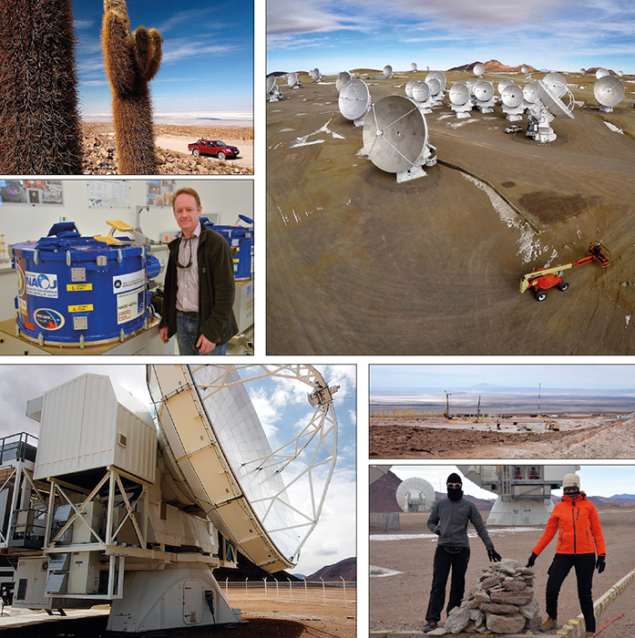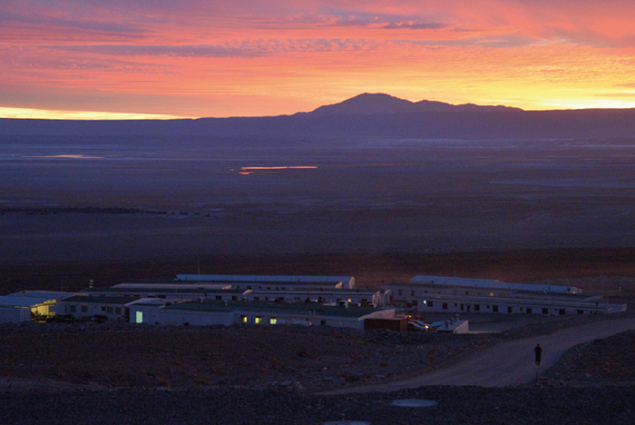Beautiful images from the Atacama desert celebrate ALMA’s scientific achievements.
Résumé
Pleins feux sur le plus grand projet astronomique du monde
Huit ans après leur première visite sur le site d’ALMA, au Chili, Paola Catapano et Mike Struik, du CERN, reviennent sur les lieux pour découvrir les 66 antennes désormais en service. La résolution obtenue, grâce à l’ampleur de l’installation, est équivalente à celle d’un télescope de 15 km de diamètre. Tous les objectifs fixés pour ALMA sont en train d’être atteints, l’un après l’autre. L’installation a commencé à être exploitée pour la science en 2011, avant son achèvement. Que peut-on attendre de cet instrument exceptionnel ? Pour les astronomes, étant donné les capacités d’ALMA, tout est possible : le prévu, et l’imprévu.

Image credits: Mike Struik, CERN.
Chajnantor highlands, Chile, 5100 m above sea level. Winding up through the Echinopsis atacamensis – a rare species of centennial cacti that grows only at altitudes between 3200 and 3800 m – the 12 m-wide road to the top has not changed since my last visit to the plateau eight years ago, nor has the magnificent backdrop of the snow-capped Andean volcanoes. It’s only at the last checkpoint, at 41 km, that I catch the first glimpse of the shiny white discs of the ALMA array. What an extraordinary emotion. The once flat, huge and literally desert site is now studded with 66 giant parabolic antennas surrounding the point once marked as the Centre of Array (COFA, see photo bottom right). The mark is still there, but ALMA today is no longer just a video animation, although its 66 antennas still look unreal against the backdrop of the thin transparent air at 5100 m. Currently in an intermediate configuration, the antennas are designed to be moved from compact to long baseline, with a maximum extension of 16 km.
Reconciliation with the cosmos
Chajnantor is probably the only place on the planet that could offer such a vast, flat and dry space at this altitude. In the indigenous “kunza” language, still spoken by the Atacameños population in the San Pedro area, Chajnantor means “the place of departure, of reconciliation with the cosmos.” No better name could have been chosen for the site that now hosts this revolutionary astronomical observatory, the most advanced and powerful array of high-precision antennas searching for our cosmic origins from their solid feet on the planet. ALMA is the only instrument offering the high sensitivity and spectral resolution – 10 times better than the Hubble Space Telescope’s – needed to catch the faint radio waves emitted by the cold and so-far-invisible regions of our universe. These submillimetre and millimetre radio waves are impossible to observe with optical telescopes. “These signals come from multiple physical processes,” explains Daniel Espada, shift leader at the time of my visit to the observatory in July. “One of these is molecules, originating from molecular transitions in the cold area of the universe, which have a little bit of energy. In some regions, we can see this primordial material, essential to life, which enables us to understand their composition. These molecules travel and radiate, and we can observe them and learn about some of their properties, including temperature density. ALMA allows us to perform high-precision studies on the properties of the interstellar dust, which is key to understanding how the energy of a galaxy is emitted.” “Nobody had ever observed those frequencies with such sensitivity,” adds astronomer Gianni Marconi, one of the permanent ESO staff on the project. “Since four years, anything ALMA has observed is a press release, because nobody had ever observed those things before. They’re all firsts.”
Amazing performance

Image credit: Mike Struik, CERN.
Indeed, all of the objectives set for ALMA are being achieved, one after the other, since it began operation for science in 2011, while the array was still under completion. Among its most striking “firsts”, we all remember the discovery, in 2012, of glycolaldehyde, in the vicinity of a sun-like star (CERN Courier October 2012 p13). This simple sugar molecule is one of the ingredients in the formation of ribonucleic acid. Its discovery showed that some of the building blocks of life existed in this system at the time of planet formation. The high sensitivity of ALMA – even at the technically challenging shortest wavelengths at which it operates – was instrumental for these observations, which were made with a partial array of antennas during the observatory’s science-verification phase.
Another primary scientific goal of ALMA was the observation of primordial galaxies, and it did so with just a bunch of antennas, in its compact configuration. The discovery was announced on the day of its official inauguration in March 2013. “By using the gravitational lensing technique,” explains Marconi, “we could shed light on 26 of the universe’s most primordial galaxies, where vast reservoirs of dust and gas are converted into new stars, at the pace of 10,000 per year.” The study concluded that these starburst galaxies are much more abundant, much further (about 12 billion light-years) and quite older (one-billion years) than previously assumed. Astronomers observed their formation as it started, two-billion years after the Big Bang. One of the galaxies discovered was already in existence a mere one-billion years after the birth of the universe, its light travelling the length of the cosmos since that time.
Since late 2014, ALMA has been experimenting with its very-long-baseline interferometry, using 22–36 antennas arranged with a baseline of up to the maximum 16 km. The resolution obtained with such an extended configuration is equivalent to that of a telescope as large as 15 km in diameter. Such a resolution enabled ALMA, among other things, to observe, for the first time, the existence of an incredibly powerful magnetic field in the close vicinity of the event horizon of a supermassive black hole in the centre of a distant galaxy (CERN Courier June 2015 p12). “Up to now, only weak magnetic fields several light-years (and not days) far from black holes had been probed,” confirms Marconi. Daniel Espada’s favourite record among such an impressive series of “firsts” is another recent one, made by ALMA in its almost final configuration (54 antennas). “The most spectacular result, for me, is the unprecedented observation of proto-planetary systems,” says Espada. “Seeing the formation of a planet-forming disc around a young star, basically a solar system like ours, live, as it happens, was an incredible breakthrough and left all of us astounded.”

Image credit: Mike Struik, CERN.
In the recently published images of the discovery of a proto-planetary system in our Galaxy, about 450 light-years away, astronomers could clearly identify dust and gas gradually forming into planets and asteroids, in the same way as it happened to Saturn’s rings or even to our own solar system, a few billion years ago. The picture (CERN Courier January/February 2015 p15) is so far the sharpest ever made at submillimetre wavelengths, with a resolution exceeding Hubble’s, and started “a new era in our exploration of the formation of stars and planets, and could revolutionise theories of planetary formation”, as Tim de Zeeuw, Director-General of ESO, declared in the press release. “We now know for sure our solar system is not alone,” comments Daniel.
What does this dream instrument have in store for the near future? Astronomers agree that with ALMA’s capacity, everything is possible – the expected and the unexpected. “ALMA can observe the entire sky, we can follow the ecliptic of our solar system, we can observe our Galaxy, we see the Santiago trail, we can observe beyond our Galaxy and anywhere else in the sky. We can also observe the composition of the atmosphere of planets and satellites near Earth. Together with optical telescopes, we’re looking for planets similar to Earth. We might not encounter other forms of life on these other planets, but we can observe their main characteristics and the atmosphere,” concludes Espada, before getting ready for his night shift, while I remain speechless in the extraterrestrial light of yet another out-of-this-world sunset over the Atacama desert.

Watch the video interviews with David Rabanus at cds.cern.ch/record/2062981 and cds.cern.ch/record/2062982.





